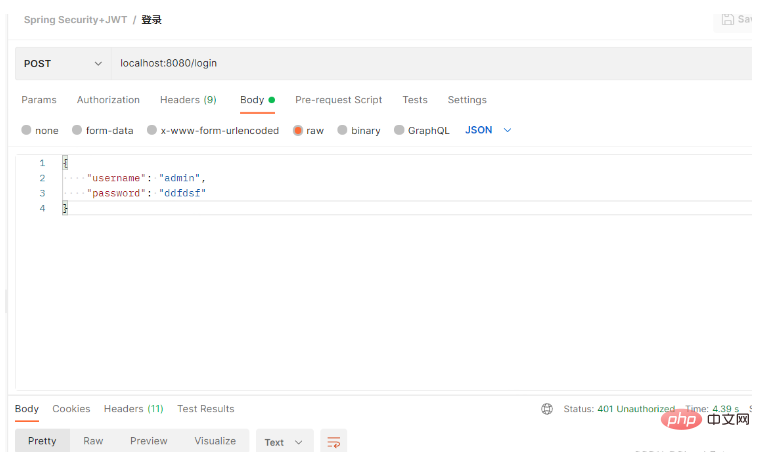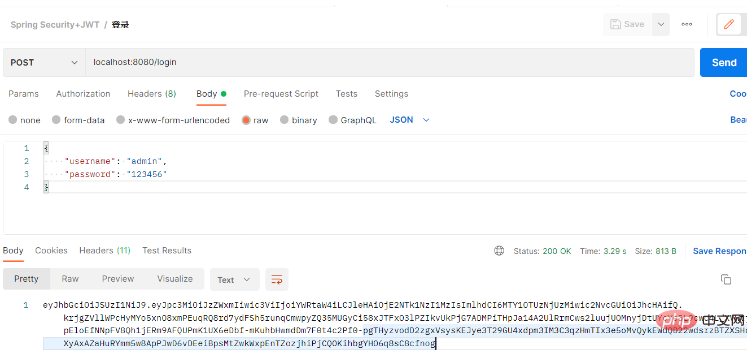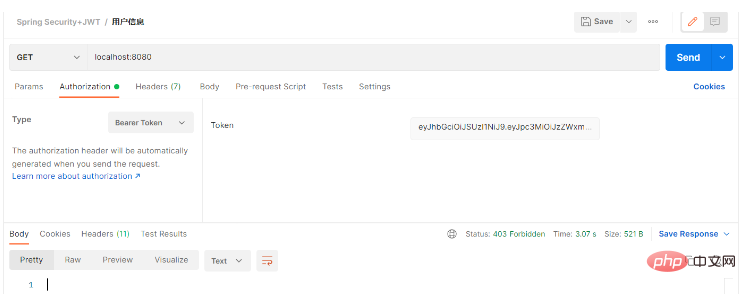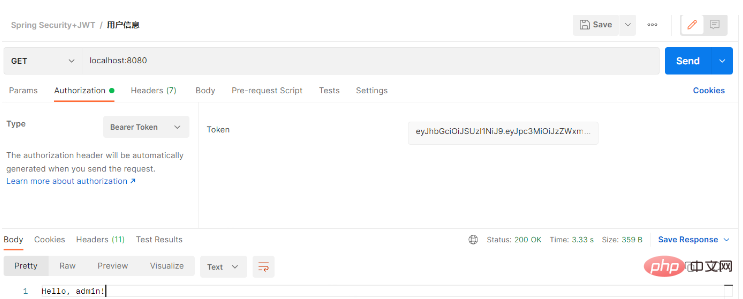 Java
Java
 javaTutorial
javaTutorial
 How to use SpringBoot+SpringSecurity+JWT to implement system authentication and authorization
How to use SpringBoot+SpringSecurity+JWT to implement system authentication and authorization
How to use SpringBoot+SpringSecurity+JWT to implement system authentication and authorization
1. Introduction to Spring Security
Spring Security is a core project of Spring. It is a powerful and highly customizable authentication and access control framework. It provides authentication and authorization capabilities as well as protection against common attacks, and it has become the de facto standard for protecting spring-based applications.
Spring Boot provides automatic configuration, which can be used by introducing starter dependencies.
Summary of Spring Security features:
Easy to use, provides Spring Boot starter dependencies, and is easy to integrate with Spring Boot projects.
Professional, providing CSRF protection, clickjacking protection, XSS protection, etc., and providing various security header integrations (X-XSS-Protection, X-Frame-Options, etc.).
Password encrypted storage, supports multiple encryption algorithms
Extremely scalable and customizable
-
OAuth3 JWT authentication support
- ##… …
Note that this article demonstrates the use of JDK and Spring Boot versions as follows:Add the following dependencies to the pom.xml file of the Spring Boot project:Spring Boot: 2.7.2
JDK: 11
Different Spring Boot versions have different configurations, but the principles are the same.
<!-- Spring Security的Spring boot starter,引入后将自动启动Spring Security的自动配置 -->
<dependency>
<groupId>org.springframework.boot</groupId>
<artifactId>spring-boot-starter-security</artifactId>
</dependency>
<!-- 下面的依赖包含了OAuth3 JWT认证实现 -->
<dependency>
<groupId>org.springframework.boot</groupId>
<artifactId>spring-boot-starter-oauth3-resource-server</artifactId>
</dependency>Mainly configures HttpSecurity Bean to generate SecurityFilterBean. The configuration is as follows:Note: Different Spring Boot versions have different configurations, but the principle is the same. This article uses Spring Boot: 2.7.2.
import com.nimbusds.jose.jwk.JWK;
import com.nimbusds.jose.jwk.JWKSet;
import com.nimbusds.jose.jwk.RSAKey;
import com.nimbusds.jose.jwk.source.ImmutableJWKSet;
import com.nimbusds.jose.jwk.source.JWKSource;
import com.nimbusds.jose.proc.SecurityContext;
import org.springframework.beans.factory.annotation.Value;
import org.springframework.context.annotation.Bean;
import org.springframework.context.annotation.Configuration;
import org.springframework.security.config.annotation.method.configuration.EnableMethodSecurity;
import org.springframework.security.config.annotation.web.builders.HttpSecurity;
import org.springframework.security.config.http.SessionCreationPolicy;
import org.springframework.security.oauth3.jwt.JwtDecoder;
import org.springframework.security.oauth3.jwt.JwtEncoder;
import org.springframework.security.oauth3.jwt.NimbusJwtDecoder;
import org.springframework.security.oauth3.jwt.NimbusJwtEncoder;
import org.springframework.security.oauth3.server.resource.authentication.JwtAuthenticationConverter;
import org.springframework.security.oauth3.server.resource.authentication.JwtGrantedAuthoritiesConverter;
import org.springframework.security.oauth3.server.resource.web.BearerTokenAuthenticationEntryPoint;
import org.springframework.security.oauth3.server.resource.web.access.BearerTokenAccessDeniedHandler;
import org.springframework.security.web.SecurityFilterChain;
import java.security.interfaces.RSAPrivateKey;
import java.security.interfaces.RSAPublicKey;
/**
* Spring Security 配置
*
* @author cloudgyb
* @since 2022/7/30 18:31
*/
@Configuration(proxyBeanMethods = false)
@EnableMethodSecurity
public class WebSecurityConfigurer {
//使用RSA对JWT做签名,所以这里需要一对秘钥。
//秘钥文件的路径在application.yml文件中做了配置(具体配置在下面)。
@Value("${jwt.public.key}")
private RSAPublicKey key;
@Value("${jwt.private.key}")
private RSAPrivateKey priv;
/**
* 构建SecurityFilterChain bean
*/
@Bean
SecurityFilterChain defaultSecurityFilterChain(HttpSecurity http) throws Exception {
//"/login"是系统的登录接口,所以需要匿名可访问
http.authorizeRequests().antMatchers("/login").anonymous();
//其他请求都需认证后才能访问
http.authorizeRequests().anyRequest().authenticated()
.and()
//采用JWT认证无需session保持,所以禁用掉session管理器
.sessionManagement().sessionCreationPolicy(SessionCreationPolicy.STATELESS).and()
//login接口可能来自其他站点,所以对login不做csrf防护
.csrf((csrf) -> csrf.ignoringAntMatchers("/login"))
//配置认证方式为JWT,并且配置了一个JWT认证装换器,用于去掉解析权限时的SCOOP_前缀
.oauth3ResourceServer().jwt().jwtAuthenticationConverter(
JwtAuthenticationConverter()
);
//配置认证失败或者无权限时的处理器
http.exceptionHandling((exceptions) -> exceptions
.authenticationEntryPoint(new BearerTokenAuthenticationEntryPoint())
.accessDeniedHandler(new BearerTokenAccessDeniedHandler())
);
//根据配置生成SecurityFilterChain对象
return http.build();
}
/**
* JWT解码器,用于认证时的JWT解码
*/
@Bean
JwtDecoder jwtDecoder() {
return NimbusJwtDecoder.withPublicKey(this.key).build();
}
/**
* JWT编码器,生成JWT
*/
@Bean
JwtEncoder jwtEncoder() {
JWK jwk = new RSAKey.Builder(this.key).privateKey(this.priv).build();
JWKSource<SecurityContext> jwks = new ImmutableJWKSet<>(new JWKSet(jwk));
return new NimbusJwtEncoder(jwks);
}
/**
* JWT认证解码时,去掉Spring Security对权限附带的默认前缀SCOOP_
*/
@Bean
JwtAuthenticationConverter JwtAuthenticationConverter() {
final JwtGrantedAuthoritiesConverter jwtGrantedAuthoritiesConverter = new JwtGrantedAuthoritiesConverter();
jwtGrantedAuthoritiesConverter.setAuthorityPrefix("");
final JwtAuthenticationConverter jwtAuthenticationConverter = new JwtAuthenticationConverter();
jwtAuthenticationConverter.setJwtGrantedAuthoritiesConverter(jwtGrantedAuthoritiesConverter);
return jwtAuthenticationConverter;
}
}application.yml
jwt: private.key: classpath:app.key public.key: classpath:app.pub
You can use the following website to generate: http://tools.jb51.net/password/rsa_encode/,
Note: The key format uses PKCS#8, and the private key password is empty.
There is one more thing that needs to be explained. I used Spring Boot’s value injection in the code:@Value("${jwt.public.key}") private RSAPublicKey key; @Value("${jwt.private.key}") private RSAPrivateKey priv;Copy after login
Are you curious about what Spring Boot is? How to convert the file corresponding to the string in the yaml file to RSAPublicKey and RSAPrivateKey?So far our project has supported JWT authentication.In fact, Spring Security did the processing for us. It helped us implement a converter ResourceKeyConverterAdapter in Spring Security. You can read the relevant source code for a deeper understanding.
But the user needs to carry a legal JWT in the request header Authorization to pass the authentication and then access the server resources. So how to issue a legal JWT to the user?
It's very simple. You can provide a login interface, let the user enter the user name and password, and issue the token after successful matching.
In fact, this is not necessary. There are other ways. For example, when we call a third-party interface, our usual approach is to apply to the third party first. After the application is approved, we can get a token. This process is the same as the issuance of a token after the login is passed above. Both of them obtain a token through legal means!5. Implement the login interface The login interface has only one purpose, which is to issue tokens to legitimate users!
Login API interface:
@RestController
public class SysLoginController {
private final SysLoginService sysLoginService;
public SysLoginController(SysLoginService sysLoginService) {
this.sysLoginService = sysLoginService;
}
@PostMapping("/login")
public String login(@RequestBody LoginInfo loginInfo) {
return sysLoginService.login(loginInfo);
}
}@Service
public class SysLoginService {
private final JwtEncoder jwtEncoder;
private final SpringSecurityUserDetailsService springSecurityUserDetailsService;
public SysLoginService(JwtEncoder jwtEncoder, SpringSecurityUserDetailsService springSecurityUserDetailsService) {
this.jwtEncoder = jwtEncoder;
this.springSecurityUserDetailsService = springSecurityUserDetailsService;
}
public String login(LoginInfo loginInfo) {
//从用户信息存储库中获取用户信息
final UserDetails userDetails = springSecurityUserDetailsService.loadUserByUsername(loginInfo.getUsername());
final String password = userDetails.getPassword();
//匹配密码,匹配成功生成JWT令牌
if (password.equals(loginInfo.getPassword())) {
return generateToken(userDetails);
}
//密码不匹配,抛出异常,Spring Security发现抛出该异常后会将http响应状态码设置为401 unauthorized
throw new BadCredentialsException("密码错误!");
}
private String generateToken(UserDetails userDetails) {
Instant now = Instant.now();
//JWT过期时间为36000秒,也就是600分钟,10小时
long expiry = 36000L;
String scope = userDetails.getAuthorities().stream()
.map(GrantedAuthority::getAuthority)
.collect(Collectors.joining(" "));
//将用户权限信息使用空格分割拼为字符串,放到JWT的payload的scope字段中,注意不要改变scope这个属性,这是Spring Security OAuth3 JWT默认处理方式,在JWT解码时需要读取该字段,转为用户的权限信息!
JwtClaimsSet claims = JwtClaimsSet.builder()
.issuer("self")
.issuedAt(now)
.expiresAt(now.plusSeconds(expiry))
.subject(userDetails.getUsername())
.claim("scope", scope)
.build();
return this.jwtEncoder.encode(JwtEncoderParameters.from(claims)).getTokenValue();
}
}Using the wrong password will return a 401 Unauthorized status code, indicating that our authentication failed!


I wrote a test interface:
@RestController
public class HelloController {
@GetMapping("/")
@PreAuthorize("hasAuthority('test')")
public String hello(Authentication authentication) {
return "Hello, " + authentication.getName() + "!";
}
}First paste the token obtained from the previous login step into the token:

我们发送请求得到了403 Forbidden的响应,意思就是我们没有访问权限,此时我们将接口权限改为“app”:
@RestController
public class HelloController {
@GetMapping("/")
@PreAuthorize("hasAuthority('app')")
public String hello(Authentication authentication) {
return "Hello, " + authentication.getName() + "!";
}
}重启项目。再次发起请求:

The above is the detailed content of How to use SpringBoot+SpringSecurity+JWT to implement system authentication and authorization. For more information, please follow other related articles on the PHP Chinese website!

Hot AI Tools

Undresser.AI Undress
AI-powered app for creating realistic nude photos

AI Clothes Remover
Online AI tool for removing clothes from photos.

Undress AI Tool
Undress images for free

Clothoff.io
AI clothes remover

AI Hentai Generator
Generate AI Hentai for free.

Hot Article

Hot Tools

Notepad++7.3.1
Easy-to-use and free code editor

SublimeText3 Chinese version
Chinese version, very easy to use

Zend Studio 13.0.1
Powerful PHP integrated development environment

Dreamweaver CS6
Visual web development tools

SublimeText3 Mac version
God-level code editing software (SublimeText3)

Hot Topics
 1376
1376
 52
52
 How Springboot integrates Jasypt to implement configuration file encryption
Jun 01, 2023 am 08:55 AM
How Springboot integrates Jasypt to implement configuration file encryption
Jun 01, 2023 am 08:55 AM
Introduction to Jasypt Jasypt is a java library that allows a developer to add basic encryption functionality to his/her project with minimal effort and does not require a deep understanding of how encryption works. High security for one-way and two-way encryption. , standards-based encryption technology. Encrypt passwords, text, numbers, binaries... Suitable for integration into Spring-based applications, open API, for use with any JCE provider... Add the following dependency: com.github.ulisesbocchiojasypt-spring-boot-starter2. 1.1Jasypt benefits protect our system security. Even if the code is leaked, the data source can be guaranteed.
 How to use Redis to implement distributed locks in SpringBoot
Jun 03, 2023 am 08:16 AM
How to use Redis to implement distributed locks in SpringBoot
Jun 03, 2023 am 08:16 AM
1. Redis implements distributed lock principle and why distributed locks are needed. Before talking about distributed locks, it is necessary to explain why distributed locks are needed. The opposite of distributed locks is stand-alone locks. When we write multi-threaded programs, we avoid data problems caused by operating a shared variable at the same time. We usually use a lock to mutually exclude the shared variables to ensure the correctness of the shared variables. Its scope of use is in the same process. If there are multiple processes that need to operate a shared resource at the same time, how can they be mutually exclusive? Today's business applications are usually microservice architecture, which also means that one application will deploy multiple processes. If multiple processes need to modify the same row of records in MySQL, in order to avoid dirty data caused by out-of-order operations, distribution needs to be introduced at this time. The style is locked. Want to achieve points
 How to solve the problem that springboot cannot access the file after reading it into a jar package
Jun 03, 2023 pm 04:38 PM
How to solve the problem that springboot cannot access the file after reading it into a jar package
Jun 03, 2023 pm 04:38 PM
Springboot reads the file, but cannot access the latest development after packaging it into a jar package. There is a situation where springboot cannot read the file after packaging it into a jar package. The reason is that after packaging, the virtual path of the file is invalid and can only be accessed through the stream. Read. The file is under resources publicvoidtest(){Listnames=newArrayList();InputStreamReaderread=null;try{ClassPathResourceresource=newClassPathResource("name.txt");Input
 How to use JWT and JWE for API authentication and encryption in PHP
Jun 17, 2023 pm 02:42 PM
How to use JWT and JWE for API authentication and encryption in PHP
Jun 17, 2023 pm 02:42 PM
With the development of the Internet, more and more websites and applications need to provide API interfaces for data interaction. In this case, API authentication and encryption become very important issues. As a popular authentication and encryption mechanism, JWT and JWE are increasingly used in PHP. Well, this article will explain how to use JWT and JWE for API authentication and encryption in PHP. Basic concepts of JWT JWT stands for JSONWe
 How to use ThinkPHP6 for JWT authentication?
Jun 12, 2023 pm 12:18 PM
How to use ThinkPHP6 for JWT authentication?
Jun 12, 2023 pm 12:18 PM
JWT (JSONWebToken) is a lightweight authentication and authorization mechanism that uses JSON objects as security tokens to securely transmit user identity information between multiple systems. ThinkPHP6 is an efficient and flexible MVC framework based on PHP language. It provides many useful tools and functions, including JWT authentication mechanism. In this article, we will introduce how to use ThinkPHP6 for JWT authentication to ensure the security and reliability of web applications
 Comparison and difference analysis between SpringBoot and SpringMVC
Dec 29, 2023 am 11:02 AM
Comparison and difference analysis between SpringBoot and SpringMVC
Dec 29, 2023 am 11:02 AM
SpringBoot and SpringMVC are both commonly used frameworks in Java development, but there are some obvious differences between them. This article will explore the features and uses of these two frameworks and compare their differences. First, let's learn about SpringBoot. SpringBoot was developed by the Pivotal team to simplify the creation and deployment of applications based on the Spring framework. It provides a fast, lightweight way to build stand-alone, executable
 How to implement Springboot+Mybatis-plus without using SQL statements to add multiple tables
Jun 02, 2023 am 11:07 AM
How to implement Springboot+Mybatis-plus without using SQL statements to add multiple tables
Jun 02, 2023 am 11:07 AM
When Springboot+Mybatis-plus does not use SQL statements to perform multi-table adding operations, the problems I encountered are decomposed by simulating thinking in the test environment: Create a BrandDTO object with parameters to simulate passing parameters to the background. We all know that it is extremely difficult to perform multi-table operations in Mybatis-plus. If you do not use tools such as Mybatis-plus-join, you can only configure the corresponding Mapper.xml file and configure The smelly and long ResultMap, and then write the corresponding sql statement. Although this method seems cumbersome, it is highly flexible and allows us to
 How SpringBoot customizes Redis to implement cache serialization
Jun 03, 2023 am 11:32 AM
How SpringBoot customizes Redis to implement cache serialization
Jun 03, 2023 am 11:32 AM
1. Customize RedisTemplate1.1, RedisAPI default serialization mechanism. The API-based Redis cache implementation uses the RedisTemplate template for data caching operations. Here, open the RedisTemplate class and view the source code information of the class. publicclassRedisTemplateextendsRedisAccessorimplementsRedisOperations, BeanClassLoaderAware{//Declare key, Various serialization methods of value, the initial value is empty @NullableprivateRedisSe



